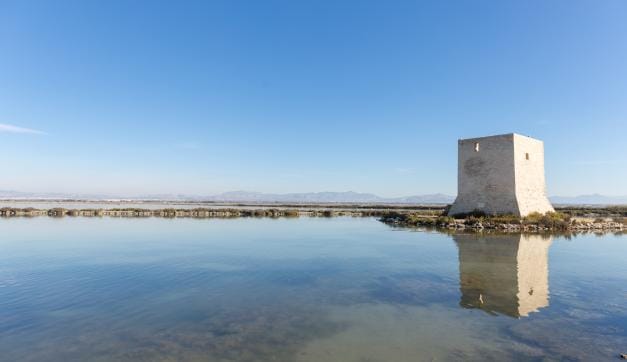THE SALT PAN
Wetland declared of international importance by being included in the RAMSAR list, also protected as a Natural Park, and declared by a European Directive Area of Special Importance for Birds.
The salt exploitation since the end of the 19th century has allowed the survival of Las Salinas, where the presence of flamenco and cigüeñuela is constant.
The dynamics of Las Salinas consists of circulating seawater through a circuit of ponds to obtain the concentration of salts as a result of evaporation. The birds feed on the fish and invertebrates that penetrate the salt flats, while the salt production benefits from the mineral wealth provided by the bird life.
Salinas de Santa Pola Natural Park is a typical example of how human action has created unique ecosystems that are still present today thanks to an economic activity such as salt production. The park has an area of 2,470 ha and is located next to El Hondo Natural Park of El Hondo, between the municipalities of Elche and Santa Pola.
Due to the uniqueness of its saline habitats, we can find botanical species such as Limonium santapolense, a typical Mediterranean wild flower. In terms of birds, the wading species located on the beaches of the salt lakes are worth highlighting.
Bird watchers are also drawn to other well-known species such as the flamingo, which has become one of the main attractions of the park, due to its beauty and gracefulness. Wetlands, salt lakes, dunes and coastal pine forests make up this nature reserve located in the province of Alicante. It is a must see for both children and adults.
Main species
Residents: Black-necked grebe, common flamingo, common shelduck, red-crested pochard, common pochard, white-headed duck, marbled duck, mallard duck, great crested grebe, little grebe, little egret, cattle egret, grey heron, western swamphen, common moorhen, Eurasian coot, pied avocet, Kentish plover, yellow-legged gull, slender-billed gull, black-headed gull, glossy ibis, black-winged stilt, bearded reedling, common ringed plover and Audouin's gull.
Summer: Squacco heron, purple heron, collared pratincole, whiskered tern, Eurasian spoonbill, booted eagle, little ringed plover, Eurasian reed warbler, gull-billed tern, common tern, little tern and western yellow wagtail.
Winter: Great cormorant, osprey, western marsh harrier, northern pintail, water rail, gadwall, Eurasian wigeon, northern shoveler, Eurasian teal, little bittern, great egret, grey plover, northern lapwing, sanderling, dunlin, curlew sandpiper, little stint, bar-tailed godwit, black-tailed godwit, Eurasian curlew, spotted redshank, common greenshank, common redshank, common sandpiper, ruddy turnstone, lesser black-backed gull, Mediterranean gull, sandwich tern, common kingfisher and bluethroat.
Birdwatching points of interest
- Tamarit tower
- Pinet itinerary
- Múrtulas ponds

Comments
Post a Comment